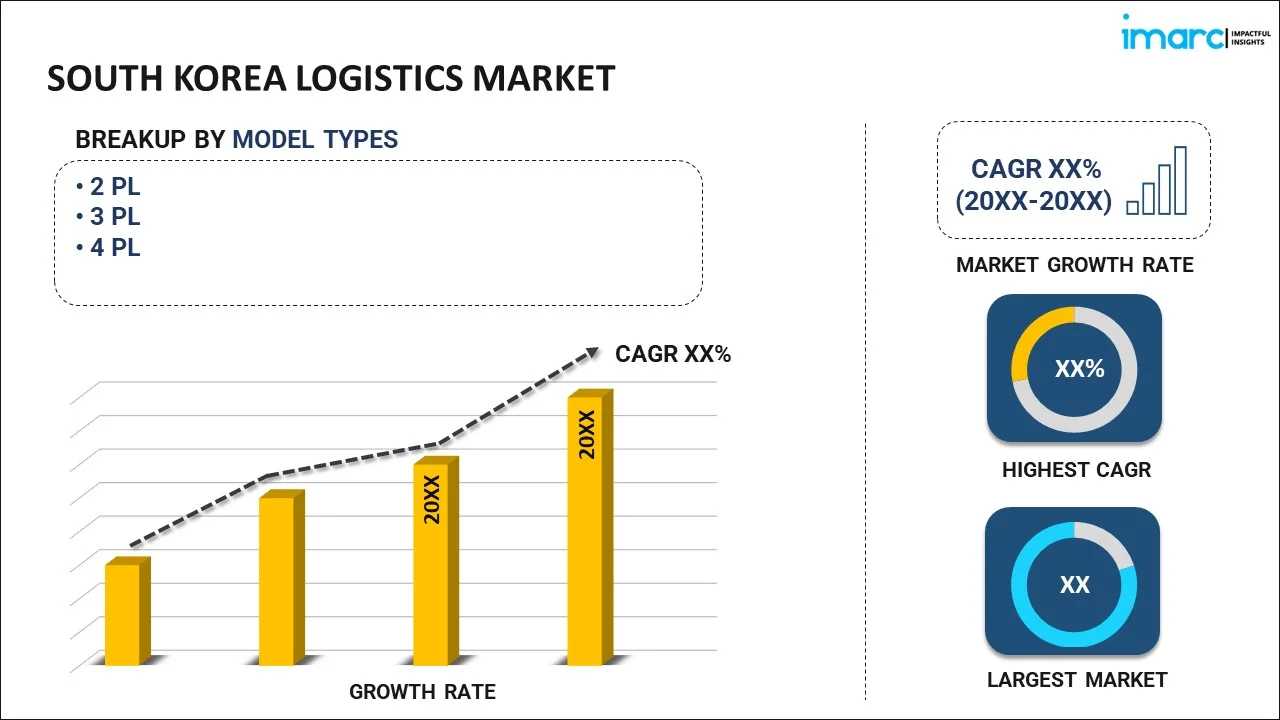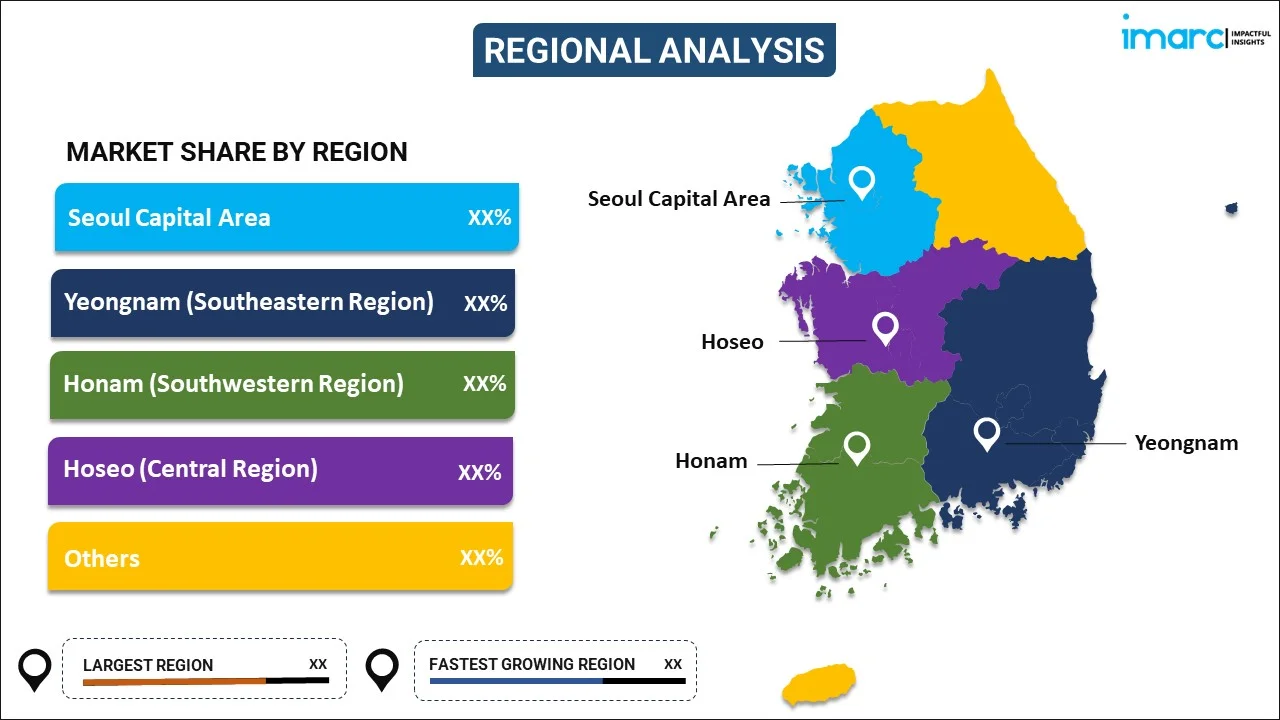
South Korea Logistics Market Report by Model Type (2 PL, 3 PL, 4 PL), Transportation Mode (Roadways, Seaways, Railways, Airways), End Use (Manufacturing, Consumer Goods, Retail, Food and Beverages, IT Hardware, Healthcare, Chemicals, Construction, Automotive, Telecom, Oil and Gas, and Others), and Region 2024-2032
Market Overview:
South Korea logistics market size reached US$ 98.8 Billion in 2023. Looking forward, IMARC Group expects the market to reach US$ 138.62 Billion by 2032, exhibiting a growth rate (CAGR) of 3.06% during 2024-2032. The country’s strategic location, booming e-commerce sector, favorable government policies, advanced technology adoption, environmental sustainability, rising healthcare demands, and the significant expansion of the aerospace industry represent some of the key factors driving the market.
|
Report Attribute
|
Key Statistics
|
|---|---|
|
Base Year
|
2023 |
|
Forecast Years
|
2024-2032 |
|
Historical Years
|
2018-2023
|
| Market Size in 2023 | US$ 98.8 Billion |
| Market Forecast in 2032 | US$ 138.62 Billion |
| Market Growth Rate (2024-2032) | 3.06% |
Logistics is a comprehensive and integral field encompassing the management of the intricate processes involved in the movement, storage, and distribution of goods and services from their point of origin to their final destination. It serves as the backbone of various industries and plays a pivotal role in ensuring the efficient and cost-effective flow of products and information across the global supply chain. Logistics entails numerous activities, including procurement, transportation, inventory management, warehousing, packaging, and the coordination of various stakeholders. This intricate web of operations strives to optimize the allocation of resources, minimize delays, reduce costs, and enhance overall customer satisfaction. Sophisticated systems and software that enable real-time tracking, data analysis, and streamlined communication are employed to address the complexity of modern logistics. Industry professionals are increasingly reliant on data-driven decision-making to enhance productivity and maintain a competitive edge in an ever-evolving and interconnected global marketplace.
South Korea Logistics Market Trends:
South Korea's strategic location as a major gateway to the Asian region, with its proximity to key markets like China and Japan, has made it a pivotal hub for international trade, thereby bolstering the demand for logistics services. In line with this, the country's robust manufacturing and export-oriented industries, particularly in electronics, automotive, and shipbuilding, have generated consistent cargo volumes, driving the need for efficient logistics solutions. Moreover, the rise of e-commerce and the booming domestic online retail sector, as consumers increasingly turn to online shopping, have spurred demand for last-mile delivery services and modern warehousing facilities to meet the growing demand for fast and reliable delivery, thereby strengthening the market growth. Besides this, the country's expanding cold chain logistics sector, driven by a growing demand for fresh and frozen food products, is presenting lucrative opportunities for the market expansion. Concurrently, South Korea's well-developed transportation network, including a sophisticated road and rail system, along with a plethora of ports and airports, has enhanced connectivity both domestically and internationally, providing an impetus to the market growth. In addition to this, the rising adoption of advanced technology and automation in logistics operations has increased efficiency, reduced costs, and improved overall supply chain performance, thereby contributing to the market's expansion. Furthermore, the government's support for Industry 4.0 initiatives has propelled the integration of technology in logistics, fueling the market's growth. Apart from this, the escalating environmental concerns and South Korea's commitment to reducing greenhouse gas emissions and promoting sustainable transport have prompted a shift toward eco-friendly logistics practices, aiding in market expansion.
South Korea Logistics Market Segmentation:
IMARC Group provides an analysis of the key trends in each segment of the market, along with forecasts at the country levels for 2024-2032. Our report has categorized the market based on model type, transportation mode, and end use.
Model Type Insights:

- 2 PL
- 3 PL
- 4 PL
The report has provided a detailed breakup and analysis of the market based on the model type. This includes 2 PL, 3 PL, and 4 PL.
Transportation Mode Insights:
- Roadways
- Seaways
- Railways
- Airways
A detailed breakup and analysis of the market based on the transportation mode have also been provided in the report. This includes roadways, seaways, railways, and airways.
End Use Insights:
- Manufacturing
- Consumer Goods
- Retail
- Food and Beverages
- IT Hardware
- Healthcare
- Chemicals
- Construction
- Automotive
- Telecom
- Oil and Gas
- Others
The report has provided a detailed breakup and analysis of the market based on the end use. This includes manufacturing, consumer goods, retail, food and beverages, IT hardware, healthcare, chemicals, construction, automotive, telecom, oil and gas, and others.
Regional Insights:

- Seoul Capital Area
- Yeongnam (Southeastern Region)
- Honam (Southwestern Region)
- Hoseo (Central Region)
- Others
The report has also provided a comprehensive analysis of all the major regional markets, which include Seoul Capital Area, Yeongnam (Southeastern Region), Honam (Southwestern Region), Hoseo (Central Region), and Others.
Competitive Landscape:
The market research report has also provided a comprehensive analysis of the competitive landscape in the market. Competitive analysis such as market structure, key player positioning, top winning strategies, competitive dashboard, and company evaluation quadrant has been covered in the report. Also, detailed profiles of all major companies have been provided.
South Korea Logistics Market Report Coverage:
| Report Features | Details |
|---|---|
| Base Year of the Analysis | 2023 |
| Historical Period | 2018-2023 |
| Forecast Period | 2024-2032 |
| Units | US$ Billion |
| Scope of the Report | Exploration of Historical Trends and Market Outlook, Industry Catalysts and Challenges, Segment-Wise Historical and Future Market Assessment:
|
| Model Types Covered | 2 PL, 3 PL, 4 PL |
| Transportation Modes Covered | Roadways, Seaways, Railways, Airways |
| End Uses Covered | Manufacturing, Consumer Goods, Retail, Food and Beverages, IT Hardware, Healthcare, Chemicals, Construction, Automotive, Telecom, Oil and Gas, Others |
| Regions Covered | Seoul Capital Area, Yeongnam (Southeastern Region), Honam (Southwestern Region), Hoseo (Central Region), Others |
| Customization Scope | 10% Free Customization |
| Report Price and Purchase Option | Single User License: US$ 3699 Five User License: US$ 4699 Corporate License: US$ 5699 |
| Post-Sale Analyst Support | 10-12 Weeks |
| Delivery Format | PDF and Excel through Email (We can also provide the editable version of the report in PPT/Word format on special request) |
Key Questions Answered in This Report:
- How has the South Korea logistics market performed so far and how will it perform in the coming years?
- What has been the impact of COVID-19 on the South Korea logistics market?
- What is the breakup of the South Korea logistics market on the basis of model type?
- What is the breakup of the South Korea logistics market on the basis of transportation mode?
- What is the breakup of the South Korea logistics market on the basis of end use?
- What are the various stages in the value chain of the South Korea logistics market?
- What are the key driving factors and challenges in the South Korea logistics?
- What is the structure of the South Korea logistics market and who are the key players?
- What is the degree of competition in the South Korea logistics market?
Key Benefits for Stakeholders:
- IMARC’s industry report offers a comprehensive quantitative analysis of various market segments, historical and current market trends, market forecasts, and dynamics of the South Korea logistics market from 2018-2032.
- The research report provides the latest information on the market drivers, challenges, and opportunities in the South Korea logistics market.
- Porter's five forces analysis assist stakeholders in assessing the impact of new entrants, competitive rivalry, supplier power, buyer power, and the threat of substitution. It helps stakeholders to analyze the level of competition within the South Korea logistics industry and its attractiveness.
- Competitive landscape allows stakeholders to understand their competitive environment and provides an insight into the current positions of key players in the market.
Need more help?
- Speak to our experienced analysts for insights on the current market scenarios.
- Include additional segments and countries to customize the report as per your requirement.
- Gain an unparalleled competitive advantage in your domain by understanding how to utilize the report and positively impacting your operations and revenue.
- For further assistance, please connect with our analysts.
 Inquire Before Buying
Inquire Before Buying
 Speak to an Analyst
Speak to an Analyst
 Request Brochure
Request Brochure
 Request Customization
Request Customization




.webp)




.webp)












